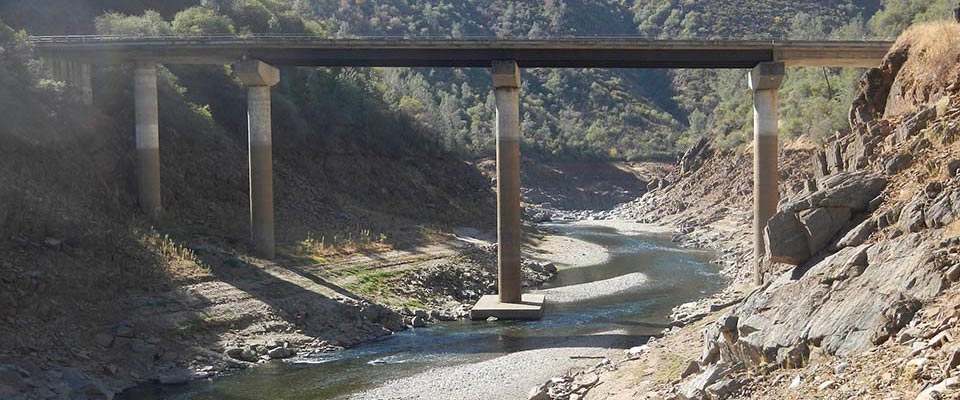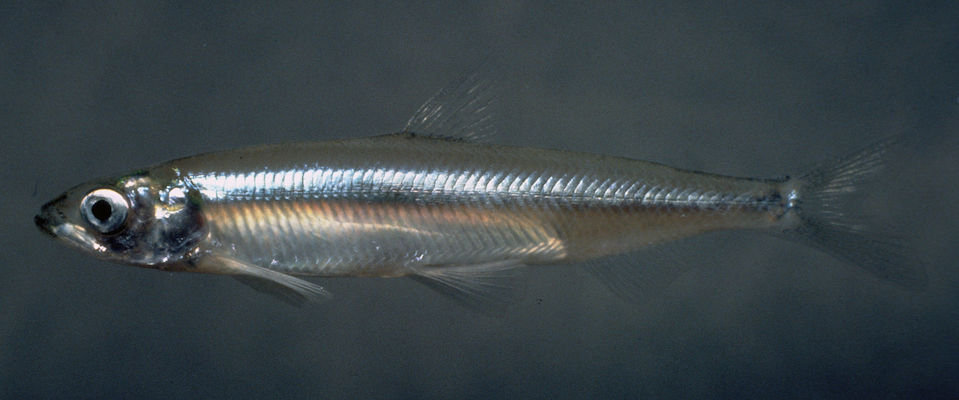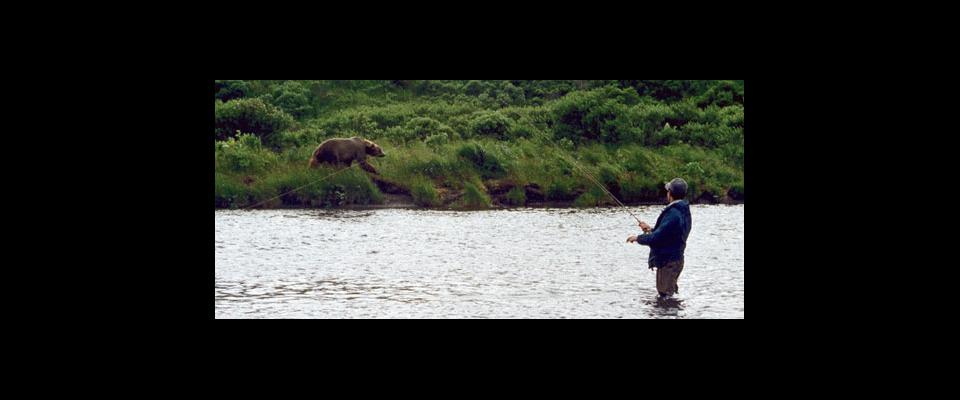If the drought is hard on California’s lawns, it’s sheer murder on the state’s fish—especially the “salmonids,” that family of cold-water fishes that includes trout and salmon. But one rare salmon species is doing fairly well in the current water crisis. And it’s being helped by the kind of project usually associated with the wholesale destruction of native fisheries.
Chinook and Coho salmon and steelhead trout are anadromous, meaning they spawn in fresh water and migrate to the sea to forage and fatten into massive, slab-sided and tasty adults. Though they once teemed in California waters, their numbers have dwindled due to pollution, water diversions—and especially dams. Virtually all of California’s major rivers have been dammed, denying thousands of miles of spawning habitat to returning salmon and steelhead. Further, the minimal downstream releases that characterize many dammed rivers are warm; the fish and their eggs are subjected to tepid water better suited for carp and catfish than salmonids, which require clean, cold water to thrive.
Last year, 90 percent of the eggs and fry (newly-hatched fish) of the endangered winter-run Sacramento River Chinook salmon died, mainly from low, warm water downstream of the dams. The equally beleaguered Sacramento spring-run salmon suffered 100 percent losses in eggs and fry, while the mainstay of California’s commercial and recreational salmon fishery—the fall-run Sacramento River Chinook—took a 97 percent loss in wild (non-hatchery) young fish and eggs. Salmon and steelhead on the Klamath/Trinity River system, California’s second salmonid stronghold, also have been hit hard due to low flows from impoundments.
So from a salmon’s perspective, dams suck. But Warm Springs Dam near Healdsburg may prove at least a partial exception to this rule.
This massive earth embankment dam was completed on Dry Creek, a tributary of the Russian River, in 1983 as a response to a devastating drought in 1976 and 1977. Though it was estimated that Lake Sonoma (the reservoir behind the dam) would take several years to top out, it completely filled in the 1982-83 rainy season due to a vigorous El Niño. It’s now a primary source of water for 650,000 Sonoma County residents.
Many environmentalists thought the dam would doom the Russian River’s salmon and steelhead runs, given their already depleted state. By the late 1960s, the Russian’s watershed was severely degraded from decades of logging, agriculture and development. The river’s once renowned steelhead runs were anemic at best. Though less scientific data was available about the Russian’s Coho salmon, anecdotal reports confirmed they were crashing as well. Warm Springs Dam, it was widely felt, would only hasten the race to extinction for both.
But the dam actually improved fish conditions on the lower reaches of Dry Creek, a major tributary of the Russian. That’s because, in its undammed state, Dry Creek was often, well, dry.
“We now have Coho runs in places where we didn’t used to have Coho runs. We’re pulling the Russian’s Coho back from the brink of extinction.”
“Most of the run-off in the Russian River watershed typically occurs in the winter,” says David Manning, who holds a UC Berkeley degree in Forestry and Resource Management and is the environmental resources coordinator for the Sonoma County Water Agency. The agency co-manages Warm Springs Dam with its owner, the U.S. Army Corps of Engineers. “In summer and fall, much of the creek was dry, with only intermittent flows, or even separated pools, in the lower section near the confluence with the Russian River.”
Warm Springs Dam did destroy scores of miles of spawning habitat on Dry Creek’s upper watershed, particularly for steelhead. But it also changed the lower creek’s flow regime; water now ran down the streambed year-round. What’s more, the water coming from Lake Sonoma is cold, well within the temperature profile favored by salmonids. A fish hatchery was established at the base of the dam to augment the steelhead and Coho runs.
But the Coho and steelhead operations have different emphases, says Gregg Horton, the lead fisheries scientist for the county water agency.
“Along with mitigating for habitat losses, the steelhead program is designed to improve the recreational harvest,” says Horton. Relative to Coho, “there are still fairly good numbers of wild steelhead in the Russian system. The Russian has 200 tributaries, and most or all of them support wild steelhead. The hatchery allows anglers to catch and keep steelhead, while releasing wild fish.” (Technicians clip the adipose fins of young hatchery-raised steelhead, allowing anglers to identify them.)
But the Coho program, continues Manning, is strictly about conservation. And salmon conservation, in turn, is about maintaining genetic diversity. When it comes to genes, most hatchery fish are truncated compared to their wild counterparts. That’s because the eggs and milt (sperm) are usually taken from a limited number of parent fish. That’s OK if you just want to catch and kill an inbred, slack-jawed and stupid, but still delicious steelhead or salmon. But it won’t do when you’re aiming for an analogue to a wild population; everything possible must be done to ensure a varied DNA palette.
“We’re collaborating with Carlos Garza, a really gifted research geneticist at the National Marine Fisheries Service,” says Manning. Garza is another Cal alum, holding a Ph.D. in integrative biology. “We were working with Coho collected from Green Valley Creek in Sonoma County, but they were pretty inbred and small. So the decision was made to cross them with fish from the Lagunitas Creek watershed (in Marin County). The resulting hybrids have been producing really healthy offspring. Carlos has been developing a spawning matrix, and he jiggles the brood stock recipe each year to maximize genetic diversity.”
But assuring a genetically robust population isn’t enough. Though the Coho emerge from their eggs in the hatchery, they are released to Dry Creek to grow into fingerling-sized smolts before migrating to the sea to mature into adults. The problem is that Dry Creek’s restored flows are too fast; it’s hard for the young salmon to find shelter and sustenance. They need “structure”—snags, rocks and logjams that slow the flows down, and create eddies and still water where the youngsters can forage, rest and hide from predators.
They’ve been working with willing local landowners to turn Dry Creek into the kind of log-strewn, overgrown stream that young salmon simply adore.
Fisheries agencies recognized the problem, and in 2008 the National Marine Fisheries Service issued a ruling to aid fish affected by Warm Springs Dam and a sister structure, Coyote Dam, on the East Fork of the Russian. Since then the county water agency and the Corps of Engineers have been working with willing local landowners to turn Dry Creek into the kind of log-strewn, overgrown stream that young salmon simply adore. A total of 1,251 root wads, logs and vertical snags and 1,213 boulders have been introduced into six miles of watercourse; 31,650 cubic yards of dirt have been removed from prime habitat zones; banks have been stabilized with willow and dogwood plantings; and a backwater channel has been created at Quivira Vineyards and Winery to provide a refuge for young fish during winter storms, when Dry Creek can brim bank to bank.
“We’ve already found young fish using these newly created habitats,” says Horton. “Coho are definitely making a living in the main stem now. And we think this could be the basis for achieving a much larger goal. We estimate there are between 300 to 500 returning adults in the system at this point, and low as that it is, it actually represents an uptick in numbers. We’re looking at 22 candidate sites for planting Coho, and we’re already planting some of them with juvenile fish. We now have Coho runs in places where we didn’t used to have Coho runs. We’re pulling the Russian’s Coho back from the brink of extinction.”
Manning acknowledges it may be difficult to accept the proposition that a dam could actually help with fish restoration, “but in this particular case it’s true. The Russian’s Coho are much more secure in the current drought than they were in 1976 to 77. And Warm Springs Dam and Lake Sonoma are definitely contributing factors.”




















